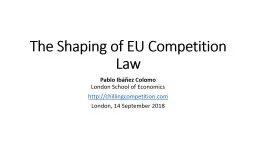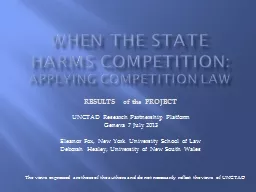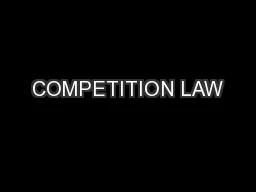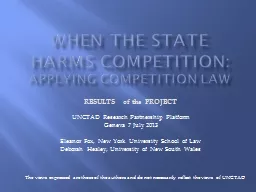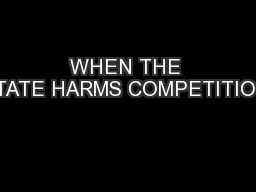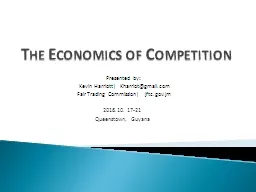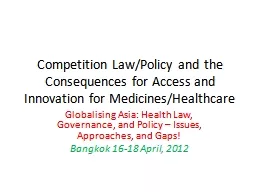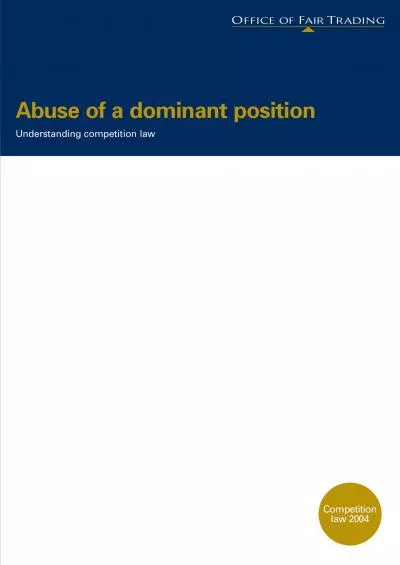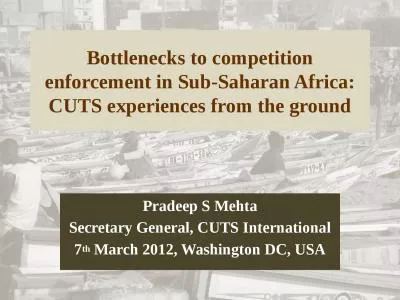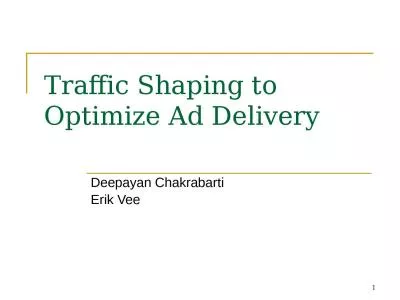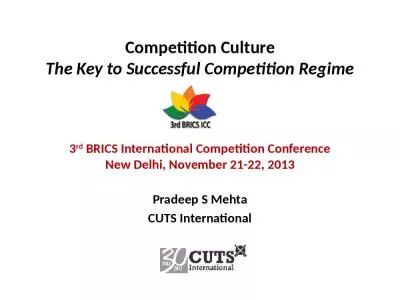PPT-The Shaping of EU Competition Law
Author : debby-jeon | Published Date : 2019-11-08
The Shaping of EU Competition Law Pablo Ibáñez Colomo London School of Economics httpchillingcompetitioncom London 14 September 2018 The idea behind the book A
Presentation Embed Code
Download Presentation
Download Presentation The PPT/PDF document "The Shaping of EU Competition Law" is the property of its rightful owner. Permission is granted to download and print the materials on this website for personal, non-commercial use only, and to display it on your personal computer provided you do not modify the materials and that you retain all copyright notices contained in the materials. By downloading content from our website, you accept the terms of this agreement.
The Shaping of EU Competition Law: Transcript
The Shaping of EU Competition Law Pablo Ibáñez Colomo London School of Economics httpchillingcompetitioncom London 14 September 2018 The idea behind the book A question In the US it is taken for granted that institutions have influenced substance. African Competition Regimes in the Global Landscape of Competition Scenario. Third CUTS-CIRC Biennial Conference. 18. th. -19. th. November, 2013 -New Delhi. Omar O . Jobe. . Director/Project Manager. Simon Roberts. 3 July 2012. Paper written in personal capacity, does not reflect the views of the Competition Commission. Introduction. Expansion of competition laws, vigorously promoted by IFIs, USA. Applying competition law. RESULTS of the . PROJECT. UNCTAD . Research Partnership Platform . Geneva 7 July 2013 . Eleanor Fox, New York University School of Law. Deborah Healey, University of New South . :. . IMPACT ON BUSINESS AND LEGAL . PRACTICE. TAN SRI DATO’ SERI SITI NORMA YAAKOB. . CHAIRMAN, . MALAYSIA COMPETITION COMMISSIO. N. 4. July 2013. COMPETITION COMMISSION ACT 2010 . (ACT 713). 2. Applying competition law. RESULTS of the . PROJECT. UNCTAD . Research Partnership Platform . Geneva 7 July 2013 . Eleanor Fox, New York University School of Law. Deborah Healey, University of New South . By: Cole David. Sam Littlefield. . Ronnie Julio. What is Traffic Shaping. Definition: Organizing and directing information within a computer network. When used correctly it can provide benefits to a network, such as.... Applying competition law. RESULTS of the . PROJECT. UNCTAD . Research Partnership Platform . Geneva 7 July 2013 . Eleanor Fox, New York University School of Law. Deborah Healey, University of New South . 2016.10. 17-21. Queenstown, Guyana. Presented by. :. . Kevin Harriott| Kharriot@gmail.com. Fair Trading Commission| jftc.gov.jm. The views expressed herein are those of this facilitator and do not necessarily reflect the views of the Fair Trading Commission in Jamaica.. Globalising Asia: Health Law, Governance, and Policy – Issues, Approaches, and Gaps!. Bangkok 16-18 April, 2012. Scheme. Gaps in policy direction. Understanding competition law/policy (CL/P). CL/P interface with health sector and related issues. Competitionlaw 2004 Fair Trading (OFT) has the power to apply and enforce Articles 81 and 82 ofthe EC Treaty in the United Kingdom. The OFT also has the power to applysame provisions are applied and e Pradeep. S Mehta. Secretary General, CUTS International. 7. th. March 2012, Washington DC, USA. Introduction. About CUTS. : From a humble beginning to an international . organisation. . Linking grassroots realities with international policy discourses. Deepayan. . Chakrabarti. Erik . Vee. Traffic Shaping. 2. Which article summary should be picked?. Ans. :. . The one with highest expected CTR. Which ad should be displayed?. Ans. :. . The ad that minimizes . By Professor Ibrahim Odeh. odeh@Columbia.edu. 2. Agenda. Construction Industry Environment . Trends Shaping the Industry. Industry Transformation Framework. Examples. 3. Agenda. Construction Industry Environment . Key to Successful Competition Regime. 3. rd. BRICS International Competition Conference . New . Delhi, November 21-22. , . 2013. Pradeep S Mehta. CUTS International. Importance of Competition Culture.
Download Document
Here is the link to download the presentation.
"The Shaping of EU Competition Law"The content belongs to its owner. You may download and print it for personal use, without modification, and keep all copyright notices. By downloading, you agree to these terms.
Related Documents

